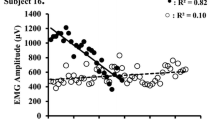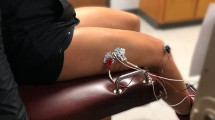Abstract
The purpose of this study was twofold: (1) to determine if the mathematical model used for estimating the EMGFT during cycle ergometry was applicable to isometric muscle actions; and (2) to compare the mean torque level from the CF test to that of the EMGFT test. The CF was defined as the slope coefficient of the linear relationship between total “isometric work” (W lim in N m s) and time to exhaustion (T lim). The EMGFT was defined as the y-intercept of the isometric torque versus EMG fatigue curve slope coefficient relationship. There was a significant (p < 0.05) mean difference between CF (6.6 ± 3.2 N m) and EMGFT (10.9 ± 4.7 N m). The results of the present study suggested that, during isometric muscle actions of the forearm flexors, fatigue thresholds estimated from the W lim versus T lim relationship (CF) are different from those estimated from electromyographic fatigue curves (EMGFT).





Similar content being viewed by others
References
Basmajian JV, DeLuca CJ (1985) Muscles alive: their functions revealed by electromyography. Williams & Wilkins, Baltimore
Bigland-Ritchie B (1981) EMG/force relations and fatigue of human voluntary contractions. Exerc Sport Sci Rev 9:75–117. doi:10.1249/00003677-198101000-00002
Bigland-Ritchie B, Donovan EF, Roussos CS (1981) Conduction velocity and EMG power spectrum changes in fatigue of sustained maximal efforts. J Appl Physiol 51:1300–1305
Bonde-Petersen F, Mork AL, Nielsen E (1975) Local muscle blood flow and sustained contractions of human arm and back muscles. Eur J Appl Physiol Occup Physiol 34:43–50. doi:10.1007/BF00999914
Bulbulian R, Jeong JW, Murphy M (1996) Comparison of anaerobic components of the Wingate and Critical Power tests in males and females. Med Sci Sports Exerc 28:1336–1341. doi:10.1097/00005768-199610000-00020
Bull AJ, Housh TJ, Johnson GO, Perry SR (2000) Effect of mathematical modeling on the estimation of critical power. Med Sci Sports Exerc 32:526–530. doi:10.1097/00005768-200002000-00040
De Luca CJ, Roy AM, Erim Z (1993) Synchronization of motor-unit firings in several human muscles. J Neurophysiol 70:2010–2023
deVries HA (1968) Method for evaluation of muscle fatigue and endurance from electromyographic fatigue curves. Am J Phys Med 47:125–135
deVries HA, Moritani T, Nagata A, Magnussen K (1982) The relation between critical power and neuromuscular fatigue as estimated from electromyographic data. Ergonomics 25:783–791
Edwards RG, Lippold OC (1956) The relation between force and integrated electrical activity in fatigued muscle. J Physiol 132:677–681
Edwards RH, Hill DK, Jones DA (1975) Heat production and chemical changes during isometric contractions of the human quadriceps muscle. J Physiol 251:303–315
Farina D, Merletti R, Enoka RM (2004) The extraction of neural strategies from the surface EMG. J Appl Physiol 96:1486–1495
Ginn E, MacKinnon L (1989) The equivalence of onset of blood lactate accumulation, critical power, and maximal lactate steady state during kayak ergometry. Abstract Proceedings of the First IOC World Congress on Sport Sciences, Colortek Printing, Colorado Springs: 34
Hermens HJ, Freriks B, Merletti R, Stegeman D, Blok J, Rau G, Disselhorst-Klug C, Hagg G (1999) SENIAM 8: European recommendations for rurface ElectroMyoGraphy. Roessingh Research and Development, The Netherlands
Housh TJ, deVries HA, Johnson GO, Housh DJ, Evans SA, Stout JR, Evetovich TK, Bradway RM (1995) Electromyographic fatigue thresholds of the superficial muscles of the quadriceps femoris. Eur J Appl Physiol Occup Physiol 71:131–136
Keenan KG, Farina D, Maluf KS, Merletti R, Enoka RM (2005) Influence of amplitude cancellation on the simulated surface electromyogram. J Appl Physiol 98:120–131
Knowlton GC, Bennett RL, McClure R (1951) Electromyography of fatigue. Arch Phys Med Rehabil 32:648–652
Lynn PA, Bettles ND, Hughes AD, Johnson SW (1978) Influences of electrode geometry on bipolar recordings of the surface electromyogram. Med Biol Eng Comput 16:651–660
Matsumoto T, Ito K, Moritani T (1991) The relationship between anaerobic threshold and electromyographic fatigue threshold in college women. Eur J Appl Physiol Occup Physiol 63:1–5
Monod H, Scherrer J (1965) The work capacity of a synergic muscular group. Ergonomics 8:329–338
Moritani T, Muro M, Nagata A (1986) Intramuscular and surface electromyogram changes during muscle fatigue. J Appl Physiol 60:1179–1185
Moritani T, Nagata A, deVries HA, Muro M (1981) Critical power as a measure of physical work capacity and anaerobic threshold. Ergonomics 24:339–350
Moritani T, Takaishi T, Matsumoto T (1993) Determination of maximal power output at neuromuscular fatigue threshold. J Appl Physiol 74:1729–1734
Pavlat DJ, Housh TJ, Johnson GO, Eckerson JM (1995) Electromyographic responses at the neuromuscular fatigue threshold. J Sports Med Phys Fitness 35:31–37
Pavlat DJ, Housh TJ, Johnson GO, Schmidt RJ, Eckerson JM (1993) An examination of the electromyographic fatigue threshold test. Eur J Appl Physiol Occup Physiol 67:305–308
Pepper ML, Housh TJ, Johnson GO (1992) The accuracy of the critical velocity test for predicting time to exhaustion during treadmill running. Int J Sports Med 13:121–124
Petrofsky JS (1979) Frequency and amplitude analysis of the EMG during exercise on the bicycle ergometer. Eur J Appl Physiol Occup Physiol 41:1–15
Petrofsky JS, Burse HL, Lind AR (1981) The effect of deep muscle temperature on the cardiovascular responses of man to static effort. Eur J Appl Physiol Occup Physiol 47:7–16
Petrofsky JS, Lind AR (1980) The influence of temperature on the amplitude and frequency components of the EMG during brief and sustained isometric contractions. Eur J Appl Physiol Occup Physiol 44:189–200
Wakayoshi K, Ikuta K, Yoshida T, Udo M, Moritani T, Mutoh Y, Miyashita M (1992) Determination and validity of critical velocity as an index of swimming performance in the competitive swimmer. Eur J Appl Physiol Occup Physiol 64:153–157
Author information
Authors and Affiliations
Corresponding author
Rights and permissions
About this article
Cite this article
Hendrix, C.R., Housh, T.J., Johnson, G.O. et al. A comparison of critical force and electromyographic fatigue threshold for isometric muscle actions of the forearm flexors. Eur J Appl Physiol 105, 333–342 (2009). https://doi.org/10.1007/s00421-008-0895-3
Accepted:
Published:
Issue Date:
DOI: https://doi.org/10.1007/s00421-008-0895-3




